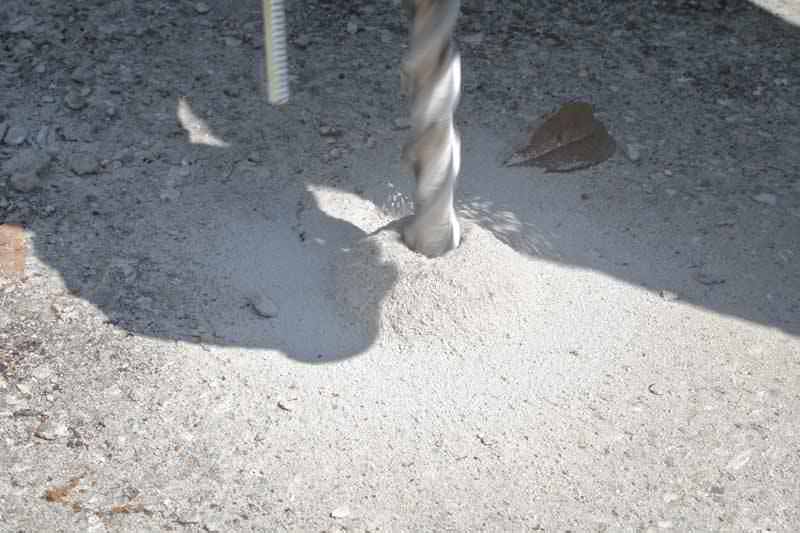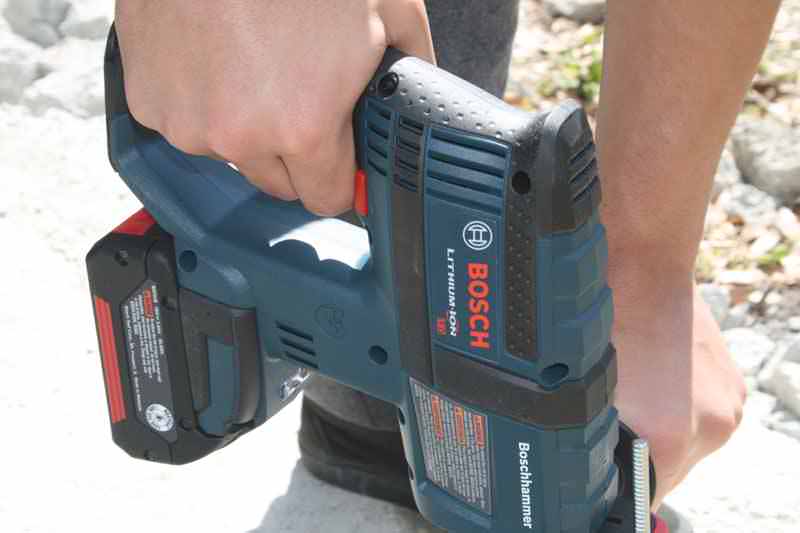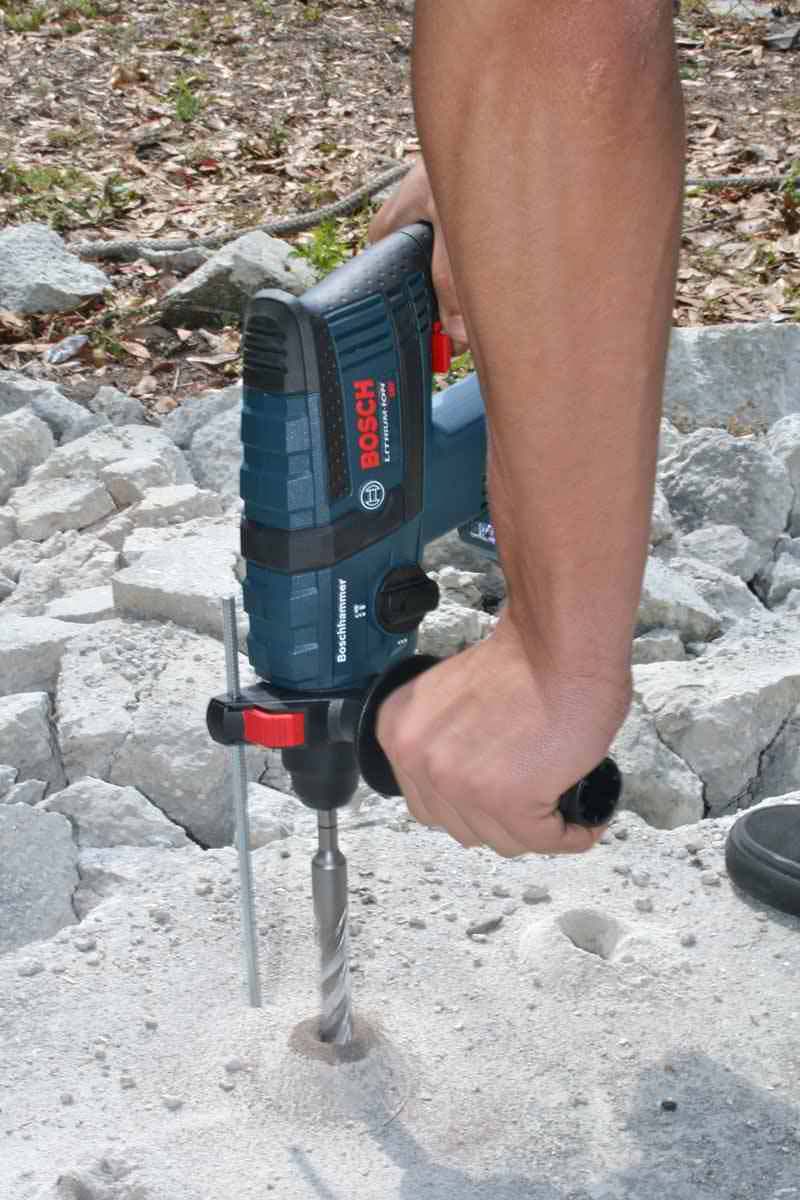Using an underpowered tool can ruin your day. If you’ve ever tried to drill into concrete with a standard drill, you’ll have experienced this first-hand. Similarly, a traditional hammer drill, while effective for basic concrete drilling, is not set up for larger jobs. Those often require bigger bits, deeper holes, and repetitive drilling. For that, you will want a serious tool. The Bosch RHH180 Cordless Rotary Hammer Drill targets that need precisely.
The Bosch RHH180 also includes convenience features like an integrated depth gauge. It lets you drill to a specific depth quickly without wasting any energy, bit-life, or time. The handle rotates a full 360 degrees, so it can work in virtually any position. You can also use it in either hand when you flip it over. It’s also a simple tool to use, with few options and little room for confusion. You just pick it up and go.
Bosch RHH180 Cordless Rotary Hammer Drill Build Quality
We’re no stranger to Bosch tools, having found them to be consistently well thought-out in their design and ergonomics. What we kept coming back to with the Bosch RHH180 Cordless Rotary Hammer Drill was its simplicity. This just isn’t a complex tool to use. It arrived in the expected retail box. Inside, we found the tool, a handle, two BAT618 lithium-ion batteries, a charger, and a rugged ballistic nylon zippered tool bag. Right off the line we found that the tool was just easy to pick up and use. After installing the front handle, it just went back into the zippered bag between jobs, ready for the next project.
The tool has nice black overmold grips on the D-handle. They also appear around the top of the tool where it’s likely to bump up against something or be gripped by your other hand. There is a forward/reverse/lock switch that sits just within reach of your thumb and forefinger when using the tool. Having two BAT618s meant that near-continuous use of this tool was within reach. On the left side of the tool is a rotary switch that sets the drill in hammer-drill (rotary hammer) or drill-only (rotary) mode. For wood you’ll want drill-only mode and for concrete jobs slap the 4550 BPM (beats per minute) pneumatic hammer-drill mode on to make quick work of your drilling.
Brushless Motor and Tool Protection
Speaking of work, the Bosch RHH180 Cordless Rotary Hammer Drill does all of its with a compact electronically commutated (EC) brushless motor. This is a high-quality motor that, by its construction, means that the tool can hold up to rigorous use and last longer. It’s also a sealed design, so you get protection from the expected dust and debris inherent in active jobsites. In terms of motor, battery, and tool protection, Bosch uses electronic motor protection (EMP) and electronic cell protection (ECP) that shuts the tool off before overload or damage can occur to either the motor or the battery.
It also lets you use both SlimPack or FatPack batteries to power the tool (though we recommend FatPack for any serious use). Even the design of the battery is unique, with integrated venting ports that work with the charger to draw air through them and cool the battery cells while charging. It’s a great design that makes good use of the natural cooling space found between the stacked individual cells.
LED Worklight and SDS-Plus Chuck
At the base of the tool, just above the battery, is an integrated LED worklight that is aimed so as to illuminate the working area of the tool. It’s fairly broad to compensate for the range of bit sizes that might be used with this tool and comes on when you squeeze the trigger – just before the tool activates (so you can use it as a light before you start drilling). The chuck is SDS-plus style, which uses fluted bit shanks to lock bits in automatically.
The SDS-plus chuck transfers energy more efficiently from the tool to the bit, unlike a traditional drill chuck where there is always the potential of slipping if it is not tight enough. There is an integrated slip clutch to keep the rotary hammer from binding when drilling into material that may have foreign objects that could grab the bit and stop it from rotating (which came in handy). Of course, the secondary reason a slip clutch is cool is that the tool doesn’t yank your arm off when it gets caught.
Testing and Use
We got a really unique opportunity to use this tool when a friend called and asked if we had anything that could help him break up an 8′ x 8′ poured concrete pad in his back yard. While we didn’t have a 35-pound demo hammer on-hand, we did have an idea… albeit one that really stressed the tool to its limits. Grabbing the Bosch RHH180 Cordless Rotary Hammer Drill and a 3/4″ SDS-plus concrete hammer bit, we drove over and surveyed the scene.
After scoping out the project, we decided to drill holes about 9-inches apart all the way through the length of the pad (which was between 8- and 9-inches thick (which is an obscenely difficult talk for any cordless concrete drill). At that point, we’d start breaking up the concrete like so much Swiss cheese. Well, it was a great way to test the tool, but not so hot of an idea for successfully (and quickly) breaking the pad apart. Remember that (unfortunately for my friend) my priority was finding some concrete to drill into!
Drill Holes with the Depth Gauge
Flipping over the Bosch RHH180 Cordless Rotary Hammer Drill, we inserted our rather large 3/4-inch SDS-plus bit. You insert it while twisting until it locks into place. We find the SDS-plus system easy to use. It’s an incredibly simple way to secure even larger bits into the tool. We then set the depth gauge so that we wouldn’t waste any energy on over-drilling.
Here is where we really began to fear for the life of the depth gauge. You see, while the rod is metal, all of the important parts that hold and stop it in place aren’t. They’re made of plastic. Over time we felt that the small teeth that hold it in place may wear down over time. It’s also wobbly and generally cheap in how it feels. The trade-off is that it can be adjusted without having to loosen the handle first. This was one of the very few areas that we felt Bosch could improve the tool. As for how well the tool performed in our testing – that didn’t disappoint in the least.
Bosch RHH180 Battery Runtime
Setting the bit against the concrete, we began to drill in the rotary hammer mode. The tool quickly drove through the concrete. Even with the grossly oversized 0.75″ concrete bit, it did well. With very little pressure or effort on our part, the tool did most of the work and we had about 9 holes drilled before the tool started to slow down. By the 10th hole, the battery was dead and we swapped it out for another and kept drilling holes.
What you need to keep in mind, however, is that this was intensely hard work. Cordless tools are usually drilling shallower and smaller 1/4″ diameter holes – and Bosch claims this tool can do roughly 100 of those at depths of 2 to 2-1/2″. We went back and did just that. After 25-30 holes, we knew the tool had enough to satisfy us. And I’m not patient enough to drill 100 holes just to prove a point!
Two Batteries for Best Performance
Since our concrete pad task next involved some sledgehammer work (and yes, we ended up eventually renting a demo hammer) we had some time to allow the first battery to finish recharging and then inserted it back into the tool. It was fascinating to observe the speed and efficiency of the tool even given the difficulty of the tests. If you’re going to tax the tool to extremes as we did, then having two batteries is a must. We suspect that most jobs will use smaller bits and shallower holes so this won’t be an issue. Also, this likely won’t be a contractor’s only Bosch tool, so that – along with the fast 30-minute recharge time – would allow for extended (dare we say near-continuous) use of the tool.

Use in Rotary-Only Mode
In our continued use of the tool, it was simply a workhorse that never wavered on a full or even partially-charged battery. Only at the last dip of the battery’s energy did the tool lose its power. For some additional testing, we took the tool to task on some pressure treated 4×4 and engaged it in rotary-only mode with a 3/4-inch SDS-plus wood bit. It was clear to me why professionals would want to use this tool, whenever possible, over a traditional hammer drill.
It’s not that much heavier considering that it works much more quickly and efficiently than our standard cordless 18V hammer drills. Again, it’s only weakness seemed to be the wobbly depth gauge. That seemed to come across as a minor distraction from an otherwise excellent experience. Back to our wood drilling – in just seconds we were through and ready for the next hole. With concrete and wood drilling happening like butter, this was a tool that quickly went through several hands as we tested it out and pushed it to its limits.
Conclusion
If you’re a professional looking to see whether the Bosch can stand up against some of the competition in terms of its portable rotary hammers, the answer is a bold “yes”. This is a great tool, and several other manufacturers don’t even offer a cordless rotary hammer solution in an 18V package. This is actually one of the less expensive solutions on the market. One small disappointment is the lack of a “chipping” mode so that you could use the hammering part of the drill without rotation. This would open up the capability of the tool to do small duty demo work.
If you plan to use this for an extended period of time or for more intensive jobs, we’d recommend going with a high-powered 36V solution like the 11536C-2 or even a corded product from Bosch. For those desiring a step up from a hammer drill, however, and who might find themselves frequently drilling holes in cinder block or concrete, the Bosch RHH180 Cordless Rotary Hammer Drill is going to be a real go-to tool for you and it will satisfy immensely. For performance, we dinged it a little for lack of battery indicators and the weak depth gauge, but it still came out strong. This is also one the lowest costs of entry into the market for cordless 18V rotary hammers. With the 3-year warranty, it’s a veritable bargain.







